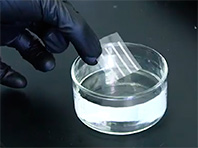
- A-
- A
- A+
Nanowires Dissolve in Cold Water
The disintegration of transient electronic systems after a preprogrammed time or a particular stimulus (e.g., water, light, or temperature) is fundamentally linked to the properties and behavior of the materials used for their construction.
Herein, we demonstrate that polymers exhibiting lower critical solution temperature (LCST) behavior can work as thermoresponsive substrates for circuitry and that these materials can be coupled with conductive nanowires to form a transient electronics platform with unique, irreversible temperature-responsive behavior.
The transient systems formed from composites of LCST polymers and conductive nanowires exhibit stable electrical performance in solution (Tsolution > LCST) for over 24 h until a cooling stimulus triggers a rapid (within 5 min) and gigantic (3–4 orders of magnitude) transition in electrical conductance due to polymer dissolution. Using a parylene mask, we are able to fabricate thermoresponsive electrical components, such as conductive traces and parallel-plate capacitors, demonstrating the versatility of this material and patterning technique.
With this unique stimulus-responsive transient system and polymers with LCSTs above room temperature (e.g., poly(N-isopropylacrylamide), methyl cellulose), we have developed a platform in which a circuit requires a source of heat to remain viable and is destroyed and vanishes once this heat source is lost.
Similar News
Links



 Elm TV
Elm TV
 Photo
Photo
 Video
Video





